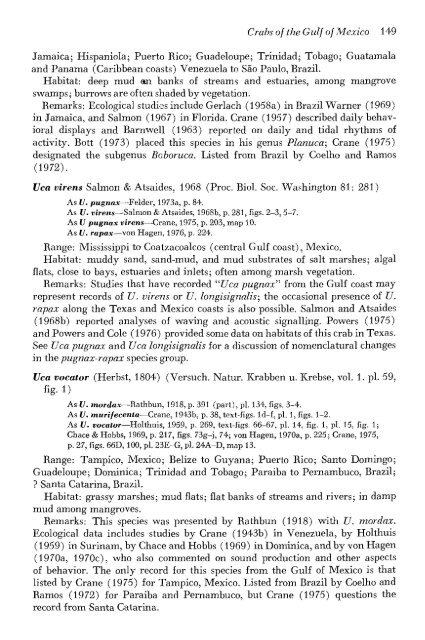Create successful ePaper yourself
Turn your PDF publications into a flip-book with our unique Google optimized e-Paper software.
Crabs of the Gulf of Mexico 149<br />
Jamaica; Hispaniola; Puerto Rico; Guadeloupe; Trinidad; Tobago; Guatamala<br />
and Panama (Caribbean coasts) Venezuela to Sao Paulo, Brazil.<br />
Habitat: deep mud an banks of streams and estuaries, among mangrove<br />
swamps; burrows are often shaded by vegetation.<br />
Remarks: Ecological studies include Gerlach (1958a) in Brazil Warner (1969)<br />
in Jamaica, and Salmon (1967) in Florida. Crane (1957) described daily behavioral<br />
displays and Barnwell (1963) reported on daily and tidal rhythms of<br />
activity. Bott (1973) placed this species in his genus Planuca; Crane (1975)<br />
designated the subgenus Boboruca. listed from Brazil by Coelho and Ramos<br />
(1972).<br />
Vca virens Salmon & Atsaides, 1968 (Proc. Biol. Soc. Washington 81: 281)<br />
As v. pKgna.i;—Felder, 1973a, p. M.<br />
As V. DiVens—Salmon & Atsaides, 1968b, p. 281, figs. 2-3, 5-7.<br />
As V pugnax virens—Crane, 1975, p. 203, map 10.<br />
As U. rapax—von Hagen, 1976, p. 224.<br />
Range: Mississippi to Coatzacoalcos (central Gulf coast), Mexico.<br />
Habitat: muddy sand, sand-mud, and mud substrates of salt marshes; algal<br />
flats, close to bays, estuaries and inlets; often among marsh vegetation.<br />
Remarks: Studies that have recorded "Uca pugnax" from the Gulf coast may<br />
represent records of V. virens or V. longisignalis; the occasional presence of U.<br />
rapax along the Texas and Mexico coasts is also possible. Salmon and Atsaides<br />
(1968b) reported analyses of waving and acoustic signalling. Powers (1975)<br />
and Powers and Cole (1976) provided some data on habitats of this crab in Texas.<br />
See Uca pugnax and Uca longisignalis for a discussion of nomenclatural changes<br />
in the pugnax-rapax species group.<br />
Vca vocator (Herbst, 1804) (Versuch. Natur. Kxabben u. ICrebse, vol. 1. pi. 59,<br />
fig- 1)<br />
As U. morrfa.v—Rathbun, 1918, p. 391 (part), pi. 134, figs. 3-4.<br />
As U. murifecenla—Crane, 1943b, p. 38, text-figs. Id-f, pi, 1, figs. 1-2.<br />
As U. rocalor—Holthuis, 1959, p. 269, text-figs. 66-67, pi. 14, fig. 1, pi. 15, fig. 1;<br />
Chace & Hobbs, 1969, p. 217, figs. 73g-j, 74; von Hagen, 1970a, p. 225; Crane, 1975,<br />
p. 27, figs. 66D, 100, pi. 23E-G, pi. 24A-D, map 13.<br />
Range: Tampico, Mexico; Belize to Guyana; Puerto Rico; Santo Domingo;<br />
Guadeloupe; Dominica; Trinidad and Tobago; Paraiba to Pemambuco, Brazil;<br />
? Santa Catarina, Brazil.<br />
Habitat: grassy marshes; mud flats; flat banks of streams and rivers; in darnp<br />
mud among mangroves.<br />
Remarks: This species was presented by Rathbun (1918) with U. mordax.<br />
Ecological data includes studies by Crane (1943b) in Venezuela, by Holthuis<br />
(1959) in Surinam, by Chace and Hobbs (1969) in Dominica, and by von Hagen<br />
(1970a, 1970c), who also commented on sound production and other aspects<br />
of behavior. The only record for this species from the Gulf of Mexico is that<br />
listed by Crane (1975) for Tampico, Mexico. Listed from Brazil by Coelho and<br />
Ramos (1972) for Paraiba and Pemambuco, but Crane (1975) questions the<br />
record from Santa Catarina.

















